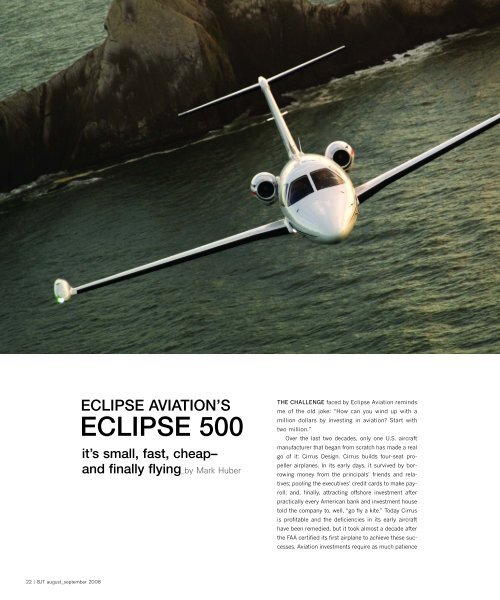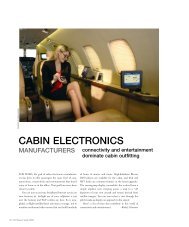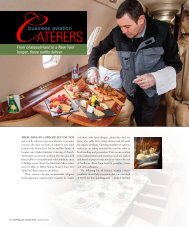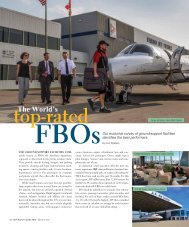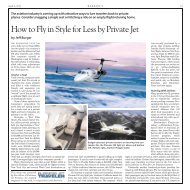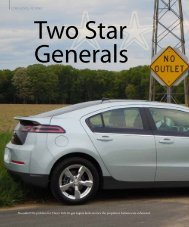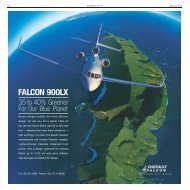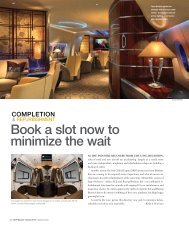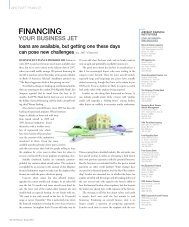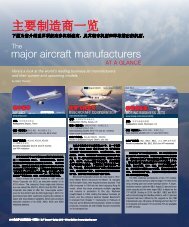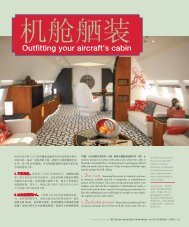ECLIPSE 500 - Business Jet Traveler
ECLIPSE 500 - Business Jet Traveler
ECLIPSE 500 - Business Jet Traveler
You also want an ePaper? Increase the reach of your titles
YUMPU automatically turns print PDFs into web optimized ePapers that Google loves.
22 I BJT august_september 2008<br />
<strong>ECLIPSE</strong> AVIATION’S<br />
<strong>ECLIPSE</strong> <strong>500</strong><br />
it’s small, fast, cheap–<br />
and finally flying_by Mark Huber<br />
THE CHALLENGE faced by Eclipse Aviation reminds<br />
me of the old joke: “How can you wind up with a<br />
million dollars by investing in aviation? Start with<br />
two million.”<br />
Over the last two decades, only one U.S. aircraft<br />
manufacturer that began from scratch has made a real<br />
go of it: Cirrus Design. Cirrus builds four-seat propeller<br />
airplanes. In its early days, it survived by borrowing<br />
money from the principals’ friends and relatives;<br />
pooling the executives’ credit cards to make payroll;<br />
and, finally, attracting offshore investment after<br />
practically every American bank and investment house<br />
told the company to, well, “go fly a kite.” Today Cirrus<br />
is profitable and the deficiencies in its early aircraft<br />
have been remedied, but it took almost a decade after<br />
the FAA certified its first airplane to achieve these successes.<br />
Aviation investments require as much patience
as money, and we live in impatient times.<br />
Now imagine how much harder it is to start a jet<br />
airplane company from scratch–one that relies on new<br />
aircraft, new manufacturing technology and mass production<br />
to make a profit; and one with a flamboyant<br />
CEO whose bold pronouncements turn the faces of his<br />
PR people purple and attract critics’ disdain and<br />
media skepticism.<br />
That’s the case with Eclipse Aviation, which began<br />
in 1998. The Eclipse <strong>500</strong> twinjet VLJ gained “provisional”<br />
certification from the FAA in July 2006 and notquite<br />
full certification in 2007 (flight into known icing<br />
conditions was approved just in June, for example). The<br />
company has spent the last two years ironing the bugs<br />
out of the design and finishing up the avionics software<br />
and functionality, well after customer deliveries commenced.<br />
Some of these mistakes were of Eclipse’s own<br />
making and some were the fault of suppliers. But basically<br />
Eclipse illustrates the business-school version of<br />
Murphy’s Law (what can go wrong, will), sort of the<br />
story of Job perfumed with jet-A fuel.<br />
The miracle is that the company still exists at all, and<br />
that, for the money–a little more than $2 million, fully<br />
loaded–the twin-engine Eclipse <strong>500</strong> is a pretty decent airplane.<br />
It’s small and relatively fast for a VLJ. And it is<br />
even less expensive than most single-engine turboprops.<br />
With full fuel (251 gallons), the Eclipse cruises at 370<br />
knots and has a range of 1,125 nautical miles. But full<br />
tanks knock the available payload (pilots, passengers and<br />
bags) down to 700 pounds. You can get the airplane with<br />
six seats, but you’d be hard-pressed to fill them on a trip<br />
lasting more than an hour.<br />
Not that you’d want to. The Eclipse’s cabin is<br />
cramped: four feet two inches tall, four and a half feet<br />
wide and just over 12 feet long. It’s OK with two adult<br />
passengers, maybe even three. But four? No way. You<br />
Price (typically equipped) $2.15 million<br />
Passengers 4<br />
Crew 2<br />
Range (4 pax, 2 crew) 1,125 nm<br />
Maximum cruising speed 370 kt<br />
Maximum takeoff weight 5,995 lb<br />
Fuel capacity 251 gal<br />
Cabin<br />
Width 4.8 ft<br />
Height 4.2 ft<br />
Length 12.4 ft<br />
Source: Eclipse Aviation<br />
AT A GLANCE<br />
NEW JET PREVIEW<br />
can also forget about bringing a lot of stuff, unless you<br />
pile it in the passenger area. The baggage compartment<br />
is only 16 cubic feet.<br />
The environmental control system (ECS) features<br />
independent zones for cabin and cockpit but the<br />
pilots, not the passengers, control the cabin zone.<br />
Most people I’ve talked to who have ridden in the back<br />
claim the ventilation blows very cold, especially at<br />
higher altitudes. Whether this is a fault of the system<br />
or the pilots is unknown. Eclipse claims there is no<br />
FAA EMERGENCY DIRECTIVE<br />
TARGETS <strong>ECLIPSE</strong> <strong>500</strong><br />
During an encounter with wind shear at Chicago Midway Airport<br />
on June 5, the pilot of an Eclipse <strong>500</strong> pushed the thrust levers<br />
(throttles) forward with enough force to cause a software error<br />
that locked both engines at full power. Unable to slow the airplane<br />
for landing, the pilot elected to shut down one engine for<br />
the subsequent landing attempt. When he did, the thrust on the<br />
working engine dropped to idle and became unresponsive to<br />
thrust-lever inputs, resulting in a hard landing that blew out both<br />
of the airplane’s main tires. No one aboard the airplane was hurt,<br />
but the incident prompted an FAA emergency airworthiness directive<br />
on June 12 requiring inspections of the thrust levers in more<br />
than 200 in-service airplanes. Nearly all of them had completed<br />
the checks at press time, with similar anomalies uncovered in<br />
two aircraft, according to Eclipse Aviation. The company is working<br />
on a software update to prevent a similar incident from<br />
occurring in the future. —Stephen Pope<br />
THE CRAMPED, 12-FOOT-LONG CABIN IS OK<br />
WITH TWO PASSENGERS AND MAYBE THREE.<br />
BUT FOUR? NO WAY.<br />
BJT august_september 2008 I 23
NEW JET PREVIEW<br />
THE <strong>ECLIPSE</strong> <strong>500</strong>’S COCKPIT EQUIPMENT<br />
ALLOWS FOR “HANDS-OFF” COUPLED<br />
APPROACHES USING THE AUTOPILOT TO<br />
EVEN THE SMALLEST AIRPORTS.<br />
problem with the ECS. Cabin pressure altitude is<br />
8,000 feet at 41,000 feet.<br />
You can order options that make the cabin more<br />
stylish and comfortable, and the company’s excellent<br />
Web site, www.eclipseaviation.com, lets you use a menu<br />
to “build” and fully visualize your airplane with the interior<br />
color scheme and exterior striping. You can also<br />
add an entertainment package that features XM radio<br />
and an MP3 player ($15,000), a refreshment center (a<br />
glorified ice drawer for $6,000), an electric-flushing toilet<br />
with privacy curtain ($10,000) and metal plating<br />
($10,000). The quality of the fit and finish is acceptable<br />
for an airplane at this price point, but nobody is going<br />
to confuse it with what you’d find in a Gulfstream.<br />
Power comes from a pair of Pratt & Whitney<br />
Canada PW610F turbofans that produce 900 pounds<br />
of thrust each and enable the airplane to take off and<br />
land in well under 3,000 feet–paved or not. The<br />
engines are more powerful–and suck more fuel–than<br />
the Williams EJ-22s that Eclipse initially planned to<br />
use. Those engines failed during flight test and caused<br />
the switch to Pratt and a rather long delay in bringing<br />
the airplane to market. They also caused the <strong>500</strong> to<br />
grow wing-tip fuel tanks. Tip tanks were common on<br />
early Learjets and on 1950s vintage jet fighters. They<br />
are a sure sign that some engineer, somewhere, somehow,<br />
has screwed up because the airplane needs more<br />
fuel but there’s no place else to put it. Fortunately,<br />
thanks to modern aerodynamics, the tip tanks on the<br />
<strong>500</strong> blend well into the wings and give the airplane a<br />
more “muscular” look.<br />
The cockpit features a three-screen Avio NG glass<br />
panel system torturously developed by Eclipse and var-<br />
24 I BJT august_september 2008<br />
ious unindicted coconspirators. Earlier this year,<br />
Eclipse announced that it was adding the Garmin GPS<br />
400W unit to the system and would retrofit it to the<br />
160 airplanes produced through March 2008 and make<br />
it standard on future production. In my opinion, this<br />
hybrid system isn’t quite as good or as clean as the<br />
integrated Garmin G1000 avionics system on the<br />
Citation Mustang and Embraer Phenom, but it will get<br />
the job done and allows for instrument approaches<br />
with the autopilot engaged–a “coupled approach” in<br />
pilot jargon–to even the smallest airports.<br />
Pilots who fly the <strong>500</strong>, and the mechanics who<br />
work on it, generally like the airplane. They do, however,<br />
recognize that it remains a work in progress and<br />
mention a few things to watch out for:<br />
THE TIRES. Eclipse designed the <strong>500</strong>’s tires to land<br />
on grass and pavement, so they’re soft. Soft tires wear<br />
out faster–in the case of the <strong>500</strong>, sometimes as soon<br />
as after 60 cycles. (A cycle is a landing and a takeoff.)<br />
So with average use, you’re looking at tire changes two<br />
to three times a year. That is a lot more than with other<br />
jets. Eclipse is working on getting a more durable tire<br />
compound but until then expect to burn some rubber.<br />
THE BRAKES. They are small and you have to baby<br />
them, but they are the primary way to slow the airplane<br />
down on the ground. The <strong>500</strong> doesn’t have anti-skid<br />
brakes, unlike most automobiles and some other small<br />
jets, such as the Citation Mustang. The good news is<br />
that the Eclipse lands slowly and its trailing-link landing<br />
gear smoothes out even the most inept landings. “It is<br />
a very forgiving aircraft,” said pilot Jeff Hultquist.<br />
PARKING. The <strong>500</strong> is a small airplane, but it doesn’t<br />
have nosewheel steering, so in some circumstances<br />
you need lots of space on the ground to maneuver.<br />
MAINTENANCE. Fixing a <strong>500</strong> is computer-intensive.<br />
Mechanics do most of the troubleshooting and a lot of<br />
the calibrating via a laptop that plugs into the instrument<br />
panel. Your mechanic will have to be trained on the<br />
airplane and a lot of his course may be new territory.<br />
Most of the operators I spoke with claimed Eclipse<br />
provided good product support. “Parts availability has<br />
been very, very good,” said Dave Hintzke, a line<br />
mechanic with Florida-based air-taxi company Day<strong>Jet</strong>.<br />
Other early problems associated with the aircraft,<br />
most notably cracking windshields, have been<br />
resolved. The few Eclipses that have come onto the<br />
used market seem to be holding their value well.<br />
Granted, the airplane had a rocky start, but the market<br />
seems to be growing more confident and comfortable<br />
with it as time progresses. ■<br />
Mark Huber welcomes comments and suggestions at:<br />
mhuber@bjtonline.com.<br />
THE <strong>500</strong>’S SMALLER SIBLING<br />
Last summer, Eclipse shocked aviation<br />
watchers by displaying a single-engine<br />
variant of its Model <strong>500</strong> twinjet VLJ. The<br />
Eclipse “concept jet,” or ECJ, featured<br />
seating for four (including the pilot) and<br />
borrowed key elements from the <strong>500</strong>,<br />
including the nose, wing, avionics and<br />
engine. Even more unusual, the ECJ was<br />
developed and built by an outside engineering<br />
firm and in secret at a NASA test facility.<br />
Cynics branded the ECJ a publicity<br />
stunt designed to deflect attention from<br />
development problems—most now<br />
resolved—on the twin-engine Model <strong>500</strong>. But<br />
those of us with a sense of VLJ history<br />
couldn’t help but notice the similarities<br />
between the ECJ and the demonstration aircraft<br />
that started the modern VLJ craze—the<br />
Williams V-JETII. So, as prices of both fuel<br />
and the <strong>500</strong> continued to rise, it came as no<br />
surprise when Eclipse announced in late May<br />
that it would proceed with the ECJ, now<br />
re-badged the Model 400. Eclipse says the<br />
$1.35 million Model 400 should be ready for<br />
customers by late 2011. It will cruise at 330<br />
knots and have a ceiling of 41,000 feet and<br />
an unrefueled range of 1,250 nautical miles.<br />
Several other companies—including<br />
Cirrus, Diamond and Piper—are betting on the<br />
emergence of the single-engine “personal” jet<br />
market. Prototypes of all three of those<br />
airplanes should be flying by the time you<br />
read this. The Diamond D-JET, while not<br />
certified, already has been flying for several<br />
years. However, although those other<br />
companies are experienced airplane<br />
manufacturers, Eclipse has its jet production<br />
line up and running now. And despite the<br />
program delays it has had with the <strong>500</strong>, by<br />
using many components from its twinjet,<br />
Eclipse should be able to fast-track<br />
development, certification and manufacturing<br />
of the 400. In time, its sales could actually<br />
surpass those of the <strong>500</strong>. “People just love<br />
this [Model 400] airplane,” said Eclipse CEO<br />
Vern Raburn. —M.H.


